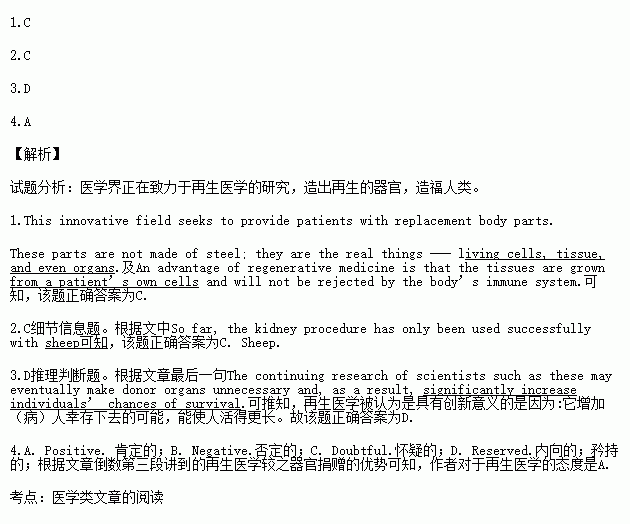题目内容
For centuries, medical pioneers have refined a variety of methods and medicines to treat sickness, injury, and disability, enabling people to live longer and healthier lives.
“A salamander (a small lizard-like animal) can grow back its leg. Why can't a human do the same?” asked Peruvian-born surgeon Dr. Anthony Atala in a recent interview. The question, a reference to work aiming to grow new limbs for wounded soldiers, captures the inventive spirit of regenerative medicine. This innovative field seeks to provide patients with replacement body parts.
These parts are not made of steel; they are the real things --- living cells, tissue, and even organs.
Regenerative medicine is still mostly experimental, with clinical applications limited to procedures such as growing sheets of skin on burns and wounds. One of its most significant advances took place in 1999,when a research group at North Carolina’s Wake Forest Institute for Regenerative Medicine conducted a successful organ replacement with a laboratory-grown bladder. Since then, the team, led by Dr. Atala, has continued to generate a variety of other tissues and organs 一 from kidneys to ears.
The field of regenerative medicine builds on work conducted in the early twentieth century with the first successful transplants of donated human soft tissue and bone. However, donor organs are not always the best option. First of all, they are in short supply, and many people die while waiting for an available organ; in the United States alone, more than 100,000 people are waiting for organ transplants. Secondly, a patient’s body may ultimately reject the transplanted donor organ. An advantage of regenerative medicine is that the tissues are grown from a patient’s own cells and will not be rejected by the body’s immune system.
Today, several labs are working to create bioartificial body parts. Scientists at Columbia and Yale Universities have grown a jawbone and a lung. At the University of Minnesota, Doris Taylor has created a beating bioartificial rat heart. Dr. Atala’s medical team has reported long-term success with bioengineered bladders implanted into young patients with spina bifida (a birth defect that involves the incomplete development of the spinal cord). And at the University of Michigan, H. David Humes has created an artificial kidney.
So far, the kidney procedure has only been used successfully with sheep, but there is hope that one day similar kidney will be implantable in a human patient. The continuing research of scientists such as these may eventually make donor organs unnecessary and, as a result, significantly increase individuals’ chances of survival.
1. In the latest field of regenerative medicine, what are replacement parts made of?
A. Donated cells, tissues and organs.
B. Rejected cells, tissues and organs.
C. Cells, tissues and organs of one’s own.
D. Cells, tissues and organs made of steel.
2. What have scientists experimented successfully on for a bioartificial kidney?
A. Patients. B. Rats. C. Sheep. D. Soldiers.
3.Why is generative medicine considered innovative?
A. It will provide patients with replacement soft tissues.
B. It will strengthen the human body’s immune system.
C. It will shorten the time patients waiting for a donated organ.
D. It will make patients live longer with bioartificial organs.
4. What is the writer’s attitude towards regenerative medicine?
A. Positive. B. Negative.
C. Doubtful. D. Reserved.


